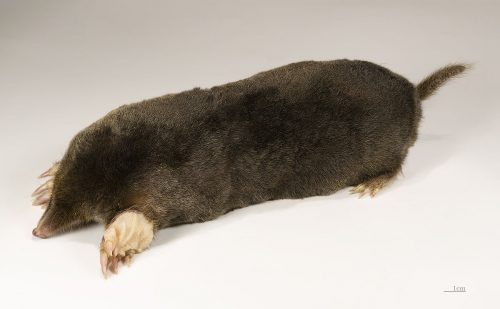Mole, a mammal that lives underground. The mole lives in a burrow system consisting of tunnels just below the surface and deeper tunnels.
Also known as:
European mole
Common mole
Northern mole
Mole (Talpa europaea). The mole is a mammal that lives underground. The mole lives in a burrow system consisting of tunnels just below the surface and deeper tunnels. The lowest tunnels can be more than a meter below ground level. The tunnels just below the surface are ‘hunting tunnels’. These can be as long as two hundred meters and in these the mole hunts earthworms, grubs, wireworms, snails, slugs, centipedes and the occasional frog. The deeper tunnels also contain the nesting area.
The excavated earth is brought to the surface and that earth forms the molehills. The molehill is also the entrance to the burrow and is used by the mole to collect nesting material (grass, moss, feathers, leaves) for the nest. That’s where the mole sleeps, too.
The mole is found on soils suitable for the mole: that is, not too wet, too sandy or a region with few earthworms. Acidic soils (pH < 3.8) are unsuitable for most earthworms, the mole’s staple food. Moles each have their own territory. That habitat ranges from 400 to 3,000m2.
Below ground the mole knows no enemies, above ground there are plenty: fox, owl, buzzard, heron, weasel and man.
Moles are active throughout the year, both at night and during the day.
The raised soil (the molehills) consists of fertile soil from the subsoil – great for use in the vegetable garden or as potting soil. A mole in the garden does not have only disadvantages: moles keep the soil airy with their tunnels and eat the larvae of insects feeding on the (garden) plants.
Where to find
- Lawn
- Vegetable plot and ornamental garden
Control
There is much in the way of combating the mole: mole clips, broken glass, poison gas, smoke (fireworks, newspaper) and devices that electrocute moles. These are not animal-friendly and know varying degrees of success.
More friendly methods include burying bottles that make a wind-induced mole-unfriendly sound or planting Imperial Crowns (Fritillaria imperialis). The flowers of the Imperial Crown stink and the smell is similar to foxes.
There are also devices for sale that are placed in the molehill that vibrate the ground and produce a high-frequency sound – moles don’t like that either. Often these devices run on a solar cell.
However: to control moles is counterproductive because an abandoned territory is immediately taken by another mole.
Prevention
It is difficult to keep moles out of the garden. A garden with a healthy ecological balance has worms (provided the soil is suitable) and therefore also moles. If a present mole is controlled then chances are that another mole from a neighboring garden will occupy the vacant territory. This also happens in spring when the young moles leave the nest and start looking for a territory of their own.

